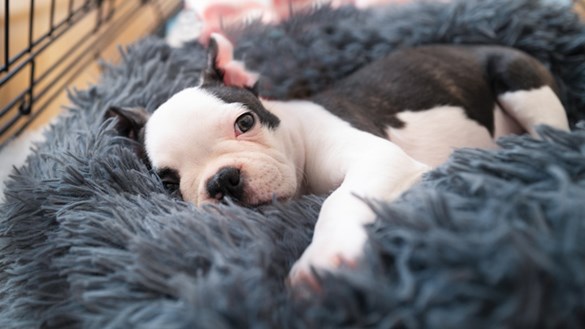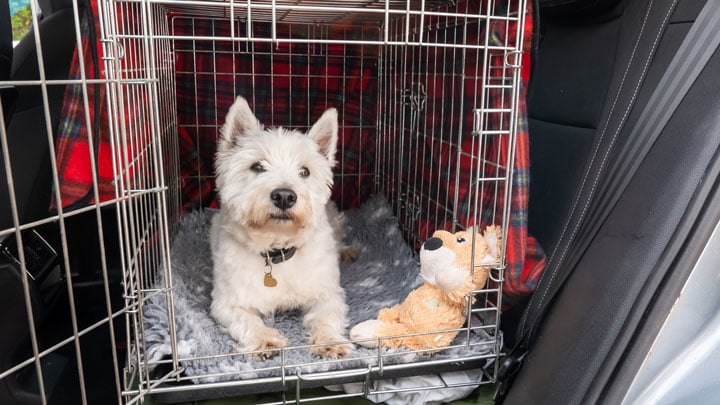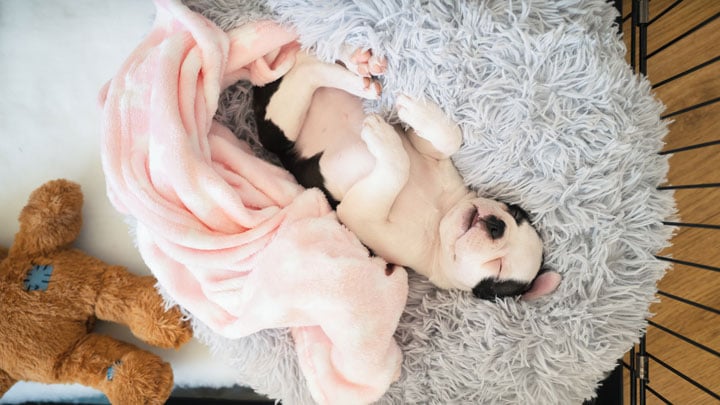Crate Training
Opinion is often divided on crates, but many experts agree that it’s a useful training tool that can help puppies and some older dogs feel secure. It’s also a helpful way to ensure that your puppy can stay safe when you’re not in the room – usually used at night, but also for short periods during the day.

Whether you use a crate or not is down to individual opinion and what works best for your family. But if you do choose to use one, it’s a good idea to take some time preparing your dog for their new bed.
Benefits of crate training
Many dog behaviourists agree crates are a really great way of caring for your dog at night-time. A dog will feel secure in a crate - it’s their own little space and can help soothe an anxious puppy when you first bring them home or when they just need a bit of quiet time.
A crate also represents a space to relax as well as your pet’s very own room. Dogs are originally pack animals and in the wild would have shared a den – a crate is like a modern-day den for them and a their very own spot where they can calm down if they become overexcited.
They’re also a great way to keep your dog out of mischief when you’re not around. And if you’re toilet training, crates are an important tool in your arsenal. Dogs are clean creatures and generally don’t like to lie on wet or soiled blankets.

Preparing for crate training
When you decide upon crate training, you’ll need to take a little time considering and setting-up a suitable space for your dog:
- The right crate – Your dog’s crate should be neither too big nor too small. You want them to have enough space so they can stand up and turn around in it but not so large they can use a corner as a toilet. Depending on the breed, investing in a crate which has dividers you can move as they grow is a great option
- The perfect location – Choose a quiet spot in your home where your dog can enjoy peace. If necessary, cover the crate with blankets to make it extra cosy for them
- What goes inside – don’t overload the crate, a comfortable bed, a blanket and a comfort toy are sufficient – enough to make it feel cosy
- If you’re bringing a puppy home for the first time, ask the breeder for a blanket with mum’s scent on it to help them settle. Don’t forget to include a water bowl to keep them hydrated, one that clips onto the side of the crate works well and will avoid spillages
What age can I use a crate from?
Starting your puppy as soon as possible, from around eight weeks (when they leave their mum), will make the introduction of a crate easier. It should help them to settle quickly into your home and they’ll view the crate as a safe haven they go into voluntarily rather than with suspicion.

When should I use a crate?
The crate should be used for short periods when your dog is unsupervised such as when you pop out to the shops for an hour, but it shouldn’t be used for long stretches of time. Use the crate at night-time to keep them comfortable and secure but never use it as a form of punishment – the crate should be a calming and comfortable space, not something they fear.
How do I crate train my puppy?
If you start your puppy early on, getting them used to the crate should go smoothly but it’s important to take it step by step:
- Let them explore – Leave the crate open for your puppy to investigate. Let them sniff and explore their new environment
- Leave the door open – Don’t lock the doors to begin with, let them move in and out of the crate freely
- Distraction toys – Encourage them into the crate for short periods and offer chew toys to distract them if they seem unsure. Note: always supervise your puppy when they’re playing with toys
- Positive encouragement – Offer lots of reassurance and encouragement as they’re learning. Never put them in the crate to punish them or tell them off when they get it wrong
- Whining/barking – If they seem distressed take them out and go back a step. Never force them to get in the crate before they’re ready. If necessary, feed your puppy in the crate to acclimatise them. A few hidden treats can also work well
- Covers – When they’re used to the crate, start adding a cover or blanket to help them feel more secure
Remember crate training isn’t about imprisoning your dog it’s about making them feel safe and secure in your home as well as teaching them responsibility.

Why does my puppy whine and bark when they’re in the crate?
Dogs are pack animals and young puppies especially aren’t used to being alone, some dogs will initially whine and bark – this means they’re not feeling secure and you should avoid letting them bark it out as this could cause a bad association with the crate.
Very young puppies may need to toilet, you should always make sure this isn’t the case. A comforting teddy (a tough one that can’t be ripped) may help some dogs – you can purchase ones with a little heartbeat that can make them feel more secure. Or some low-volume music as background noise.
Young puppies often found it difficult to settle for the first few nights in a new home, this is part of being a puppy owner! However, you can improve this quickly by encouraging them to use the crate throughout the day whilst you’re around – if they associate the crate with fun, safe and secure they’ll be going through the night in no time.
Many families continue to use the crate for many months, others only use it for a few – once again this is a personal choice and the important thing is what works for your dog and your family.


